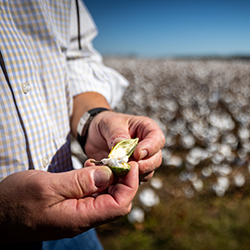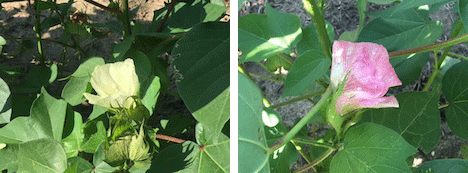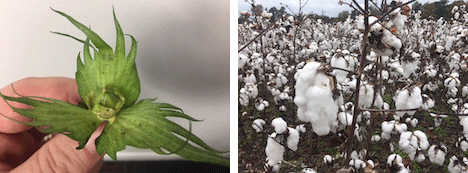This post is part of our blog series entitled “The Journey of Cotton.” This series will focus on the seven unique steps that it takes to process cotton, starting with the planting of the crop to the point it becomes a specific consumer product. Today’s post will focus on the first step in that journey: growing the cotton.
For the Modern Farmer, Less Is More
Farming practices have evolved over the years, and the motto for today’s cotton farmer is “less is more.” Precision agriculture is being incorporated all across the cotton belt. Fertilizer, insecticide, and water usage is down nearly 50% over the last 30 years, mainly due to farmers putting the exact rate in the exact place to maximize yields. Less input cost equals maximum returns, allowing for the American farmer to continue the practice for generations to come.
The Key Planting Stat: 60 Degrees
Each spring producers prepare for planting the annual cotton crop. The fields in south Texas are planted in early February, while the farms in the west and southeast portions of the U.S. are typically planted in late April or early May. The main factor in deciding when the cotton seed is planted is the amount of heat units in the soil. Cotton thrives in warm weather, so farmers do not want to plant until the ground stays above 60 degrees through the night. The seeding is done with mechanical planters pulled by a tractor. The planter opens a small furrow in each row to an appropriate depth, drops the exact amount of seed that the farmer wants, and covers the earth on top of them.
After 60 Days, the “Squares” Appear
For the first two months after planting the farmer’s main priority is keeping the weeds and grass out of the cotton. The weeds and grass compete with the cotton plant for the soil’s nutrients and water. Lots of sunlight and heat units are necessary for the plant to make a strong root system. About 60 days after planting, flower buds called squares will appear on the individual plants. In another 20 days or so the blossoms will open. Their petals change from yellow to a reddish pink, then finally they wither and fall to the ground after day three.
At Long Last, the Cotton Emerges
What’s left on the plant is a green pod called the cotton boll. Inside the boll the cotton fibers begin to mature and expand with the help of sunlight and moisture. The boll ripens, then turns brown and splits open to reveal the fluffy, white cotton. After all of the bolls have opened, the farmers prepare the plant for harvesting.
Up Next: Cotton Harvesting
This is only part two of this seven-part series. (If you missed our Introduction, be sure to visit that blog post.) The next step in the cotton journey is harvesting, so keep an eye out on our blog for updates. You can also enter your email address in the “Stay in the Know” field in the right margin to have blog updates sent directly to your inbox.


